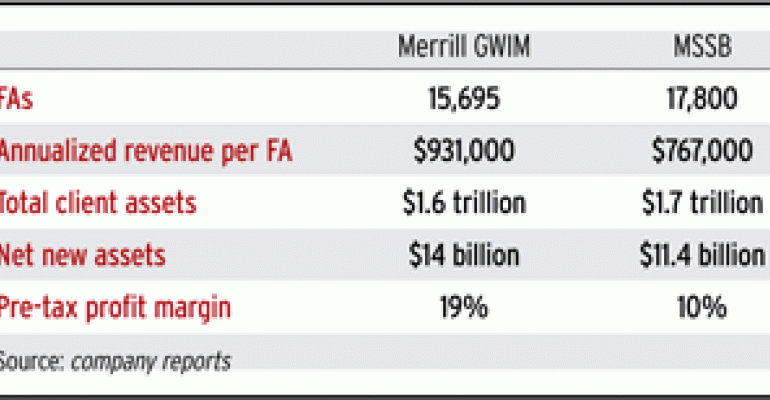In a disappointing quarter for Morgan Stanley, the firm’s global wealth management group was, once again, a bright spot, with revenue, earnings and client assets up, though advisor headcount and pre-tax profit margins were down. Morgan’s other two divisions—institutional securities and asset management recorded declines in income and revenues, though the firm saw strong performance in equity sales and trading, fixed income and M&A.
“We are pleased with our progress and the MSSB integration is on track,” said Morgan Stanley CEO James Gorman of the wealth management group on a conference call. “Margins were lower as we indicated they would be on the last quarterly conference call.”
The global wealth management group represented over a third of Morgan Stanley’s profits for the quarter, with pre-tax income of $348 million, up 25 percent from the year ago. Net revenues totaled $3.4 billion, up from $3.1 billion on higher commissions and asset management revenues. Pre-tax margins slipped to 10 percent, down from 12 percent in the fourth quarter, and still far short of a long-term target of 20 percent.
Retail clients gave Morgan Stanley more assets to manage, as the division reeled in net new assets of $11.4 billion, bringing total client assets to $1.7 trillion. Client assets in fee-based accounts continued to grow, rising 21 percent to $501 billion, almost a third of total client assets. Assets in millionaire household accounts rose 11 percent to $1.28 trillion.
Integration Progress
As on last month’s call, Chief Financial Officer Ruth Porat discussed the progress of the Morgan Stanley Smith Barney integration and the division’s profit margin targets. Morgan Stanley financial advisors will move onto the firm’s new "3D" operating platform by the third quarter of this year, she said, while Smith Barney advisors will get there by the first half of 2012. These moves will help the division reach that 20 percent profit margin target.
So will growth in GWM lending business through the private banking division of the firm, which Morgan is expanding. The private banking business exists primarily to work with FAs to meet the credit and lending needs of clients (mortgages, non-purpose loans, structured loans, business lines of credit). Morgan had 160 private bankers at the end of the year, 178 at end of the first quarter and a target of 180 for the year.
Porat also pointed out that a portion of GWM’s profitability is driven by the spreads the firm earns on bank deposits (the difference between what they earn on the deposits and pay in interest to depositors). She noted that with the fed funds rate extremely low spreads are pressured, but should improve as interest rates increase.
Recruiting and Turnover
Morgan Stanley Smith Barney is still the leader by far in terms of financial advisor headcount among the major Wall Street brokerages, but total FA headcount slipped in the quarter by around 243 to 17,800, “as underperformers were pruned from the ranks,” spokesman Jim Wiggins said in a statement. Morgan announced in March that it had cut around 300 trainees, which contribute to FA headcount numbers. Turnover within top two quintiles remained near historic lows, however, Porat said on the conference call. She also warned that there could be additional cuts in low-end producers next quarter. Annualized revenue per FA rose to $767,000 for the quarter, from $742,000 in the fourth quarter.

Merrill Lynch, which reported earnings last Friday, has far fewer financial advisors, but much higher annualized revenue per FA. “This year is going to be vital in fight over who is Number 1 between Merrill and Morgan,” said Alois Pirker, Aite Group analyst, last week. “Assets, productivity, number of advisors, these are all the key indicators. Who is the leading franchise? Merrill, who used to be it, has a real competitor in Morgan Stanley now. Whoever has a really good 2011 will be well positioned to take that top spot.” See the chart on the right for a comparison between the two firms. Wells Fargo reported earnings on Wednesday.
Compensation expenses for Morgan Stanley’s GWM division rose to $2.1 billion for the quarter, up 8 percent versus the year ago quarter, but the compensation to net revenue ratio fell to 62 percent from 64 percent a year ago. The number of branches declined to 832 from 851 in the fourth quarter.
Overall, Morgan Stanley reported first quarter earnings of $966 million, down from $1.8 billion last year, beating analyst expectations. Revenues for the quarter totaled $7.6 billion, down from $9.1 billion a year ago. The latest quarter’s results included an after tax loss of $425 million from the bank’s Japanese joint venture, Mitsubishi UFJ Morgan Stanley Securities. Morgan and Mistubishi UFJ Financial Group announced Thursday that they will convert MUFG’s outstanding convertible preferred stock in Morgan to common stock, giving MUFG an ownership stake of 22.4 percent in Morgan Stanley.


